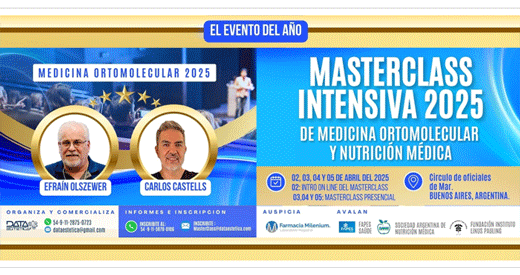Buenos Aires, Viernes 19 de Diciembre de 2025
Acerca de EsteticaMedica | Clasificados | Eventos | Actividades | Staff | Publicidad | Contacto
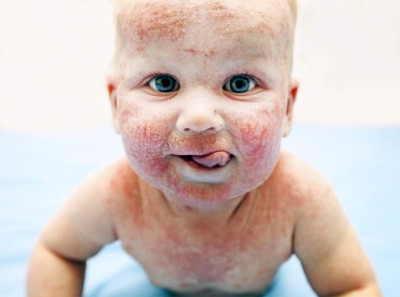
06-08-2021 | Dermatología
Dermatitis atópica: causas, efectos y estrategias para limitar su evolución
Sin ser contagiosa es una enfermedad crónica que comienza desde la más tierna infancia y evoluciona por brotes de eczema; fases agudas que tienen un impacto importante en la calidad de vida del paciente. En Occidente, el número de casos se ha duplicado o incluso triplicado.

15-03-2019 | Dermatología
Vitiligo: causas, tipos, evolución y tratamientos
Aproximadamente el 1% de la población padece vitiligo, sin distinción de raza o país y sin que predomine en uno u otro sexo. Consecuencia de la ausencia de melanina, puede aparecer a cualquier edad, pero el pico de incidencia se produce en torno a los 20 años de edad.

03-02-2018 | Dermatología
Día Internacional contra el Cáncer: la dermatología y el cáncer de piel
Si bien hace años que los médicos de todo el mundo dedican el 4 de febrero a generar conciencia sobre la enfermedad, el doctor Andrés Cordero señala que en dermatología los paciente aún no están lo suficientemente alertados sobre la prevención del cáncer cutáneo.
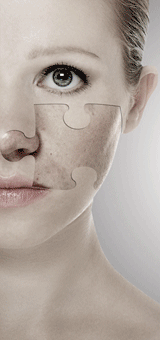

29-12-2017 | Dermatología
Afecciones cutáneas de origen psiquiátrico: diferencias entre el hombre y la mujer
Cuando en el hombre las situaciones sociales son adversas, aparece una mayor repercusión de psicopatologías y más afectación de enfermedades cutáneas con respecto a la mujer. En estas situaciones la calidad de vida del hombre es mucho menor. Las dermatitis artefactas.

04-07-2017 | Dermatología
OMS: Reporte Global de Psoriasis
Según lo publicado en el último reporte global de la Organización Mundial de la Salud sobre psoriasis, esta enfermedad tiene una prevalencia a nivel mundial que oscila entre el 2 y el 3% de la población, afectando a casi 125 millones de personas en todo el planeta de cualquier edad.
Dermatología | MESOTERAPIA
Melasma: tratamiento mesoterápico con ácido tranexámico al 5%
Como todos los tratamientos del melasma son de alto precio y de tiempo prolongado, el Dr. Carlos Rosales, de Guatemala, plantea una nueva terapia: ácido Tranexámico al 5% en forma de mesoterapia, ya que el ácido Tranexamico es de fácil manejo y fácil de conseguir y, al diluirlo a bajas concentraciones, se vuelve una terapia económica.
Martes 23 de Julio de 2013 // Por Dr. Carlos Rosales (Guatemala)
 El melasma es un trastorno adquirido de la pigmentación cutánea, caracterizado por la aparición de máculas hiperpigmentadas irregulares que afecta zonas fotoexpuestas, especialmente de la cara, encontrándose a nivel epidérmico, dérmico o mixto.
El melasma es un trastorno adquirido de la pigmentación cutánea, caracterizado por la aparición de máculas hiperpigmentadas irregulares que afecta zonas fotoexpuestas, especialmente de la cara, encontrándose a nivel epidérmico, dérmico o mixto.Por su localización pueden ser centro faciales, malares o mandibulares. En menos ocasiones las manchas también se pueden encontrar en antebrazos y escote.
Afecta especialmente a las mujeres y a todos los grupos étnicos, pero es más prevalente en los fototipos oscuros, grado IV a VI según la escala de Fitzpatrick.
El melasma no solo afecta físicamente a los pacientes sino también conlleva a una afección psicológica; alterando sus relaciones interpersonales, laborales y con sus familiares.
Es sabido que por ser una enfermedad cutánea de difícil manejo y de largo tiempo de evolución, su tratamiento es costoso y prolongado. Actualmente existen múltiples terapias, como:
- Cremas:
- Inhibidores de la síntesis de melanina, transcripción y glicosilación de la tirosinasa: Tretinoína, Glucosamina, Retinol, N-acetil glucosamina, Retinaldehido.
- Inhibición de la tirosinasa: Hidroquinona, Mequinol (4-hidroxi-anisole), Arbutina, Ácido azeláico, Ácido kójico.
- Degradación de la tirosinasa: Acido elágico, Resveratrol, Oxyresveratrol.
- Inhibición de la transferencia de la melanina a los melanosomas: Acido linoleico.
- Inhibición de la transferencia de los melanosomas del melanocito al queratinocito: Tretinoína.
- Antiinflamatorios: Niacinamida, Soja, Extractos lácteos, Corticoides tópicos.
- Eliminadores de reactivos de oxigeno: Corticoides tópicos, Ácido gliciretínico.
- Aumento del recambio epidérmico: Vitamina C, Vitamina E, Ácido tioctico, Retinoides, Ácido láctico, Ácido glicólico, Ácido Salicílico, Liquirtin.
- Láser.
- Luz Intensa Pulsada.
- Dermoabrasión.
- Microdermoabrasión.
- Mesoterapia con los mismos principios activos de cremas aclaradoras como con ácido glicólico, tretinoína, vitamina C, te verde, etc.
Como todos estos tratamientos son de alto precio y de tiempo prolongado, se plantea una nueva terapia, como lo es el ácido Tranexámico al 5% en forma de mesoterapia, ya que el ácido Tranexamico es de fácil manejo y fácil de conseguir y, al diluirlo a bajas concentraciones, se vuelve una terapia económica.
El ácido Tranexámico es un medicamento hidrofílico, sintético, semejante a la lisina, inhibidor de la plasmina (antifibrinolítico) su eliminación 95% renal, lo hay en presentación para mesoterapia: ampolla de ácido tranexámico al 5% con vehículo csp 5 ml con pH 6.
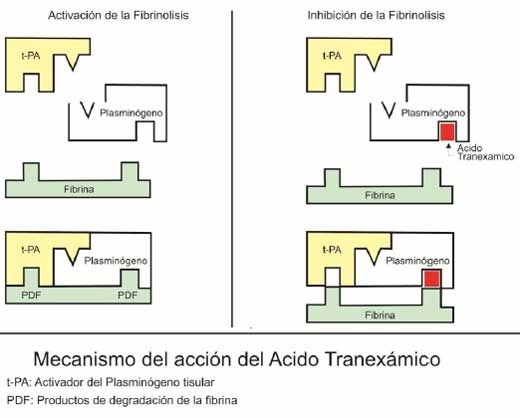
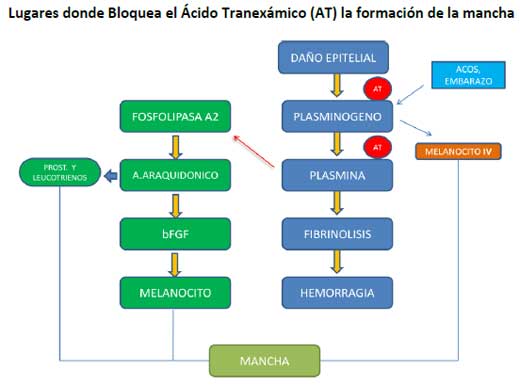
Para comprobar la efectividad del ácido Tranexámico al 5% en forma de mesoterapia se hizo la investigación a 20 mujeres con edades entre los 18 a 70 años, afectadas con melasma, tratadas y no tratadas de cualquier fototipo, de cualquier región del país, con melasma. Sanas o controladas medicamente, sin coagulopatías, sin cardiopatías y sin tratamiento anticoagulante como la vitamina E, ASA, etc. No embarazadas, o dando de lactar, con la piel sana, sin infecciones localizadas en cara, como herpes, impétigo, fisuras, cortes, etc. El tiempo fue de 12 semanas.
Los materiales utilizados: ampolla de ácido tranexámico al 5% con vehículo csp de 5ml con pH 6. Anestésico tópico fuerte. Y todo lo necesario para realizar una mesoterapia. Fotografías antes y después.
Resultados
20 pacientes mujeres de edad entre 20 y 70 años. 25% del área rural y 75% de la ciudad.
- El 75% refirió que su causa de melasma era el sol, y un 25% el embarazo.
- El 75% de las pacientes no habían sido tratadas, un 25% habían sido tratadas anteriormente con cremas y tratamientos despigmentantes sin buenos resultados.
- El 85% de las pacientes evaluadas no utilizaban protector solar, luego lo han empezado a utilizar como cuidado diario.
- El 80% de las pacientes no habían tenido ningún tratamiento de medicina estética, dentro del 20% restante el mayor tratamiento fueron los peelings.
- El 50% de pacientes eran fototipo IV, un 40% fototipo III, y el 10% el resto de fototipos.
- El 50% de las pacientes presento un melasma mixto, un 40% un melasma dérmico y un 10% un melasma epidérmico.
- El 50% del melasma era de distribución malar.
- El 50% de las pacientes refirió que el procedimiento presentaba un dolor tolerable.
- El 70% de las pacientes estuvo conforme con el resultado obtenido al finalizar el estudio.
Fotos de pacientes (antes y después)
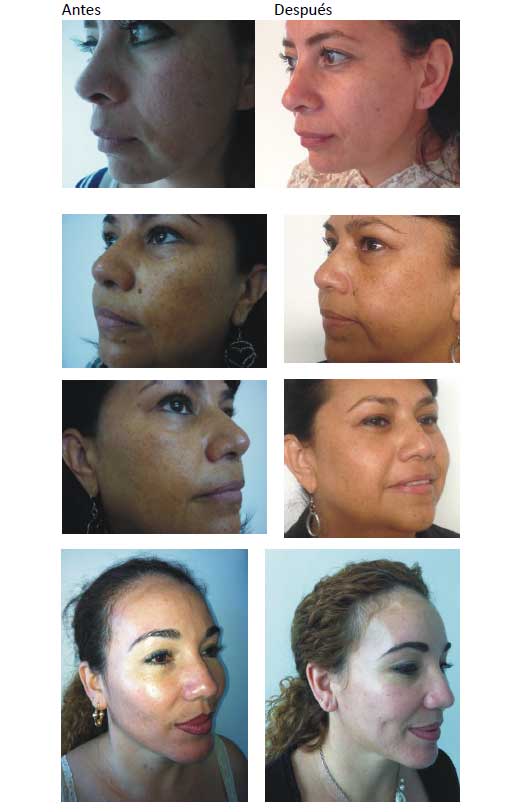
Resultados de tratamiento mesoterápico con ácido tranexámico combinada con otras técnicas de medicina estética:
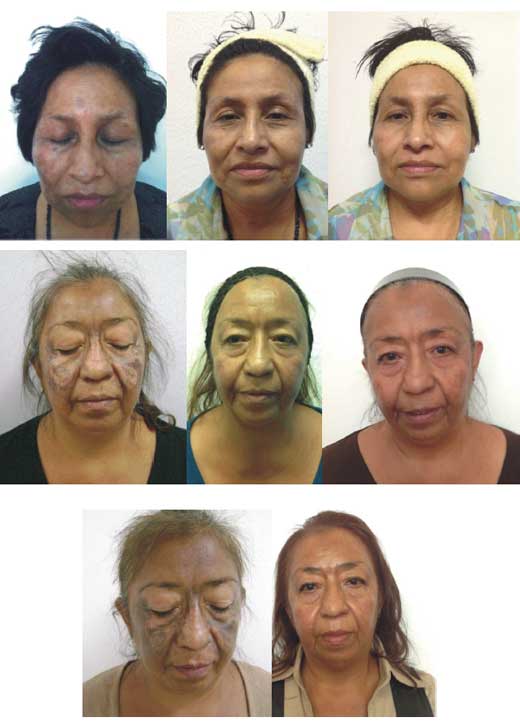
Conclusiones
- El ácido Tranexámico al 5% con pH 6 administrado en forma de mesoterapia técnica de micro pápulas sí es efectiva en el tratamiento del melasma, pero dado el dolor que producen las pápulas se prefiere hacer técnica de Nappage, siendo más tolerado y mismos resultados.
- El tratamiento presenta un dolor tolerable a la aplicación. Su resultado es lento, pero al final de las 10 semanas las mejorías son notorias, por tal motivo 50% de las pacientes abandonaron el estudio.
- Todas las pacientes refirieron que asociaban al sol y el embarazo como posibles causas de las manchas, y el tener un caso de melasma siempre conlleva una afección psicológica afectando las relaciones sociales.
- El abandono por parte de los pacientes de los tratamientos es la principal causa de que estos no funcionen.
- El tratamiento mesoterápico de melasma con ácido tranexámico, combinado con técnicas de medicina estética optimiza los resultados, tales como peelings, microdermoabrasión y cremas domiciliares, entre otras.
Agradecimiento especial
Agradecemos la provisión del material para el trabajo de campo a Pharmacie de la Santé, Farmacia & Laboratorio, Buenos Aires, Argentina.
Bibliografía
Abarca J, Odilla Arrollo C, Blanch S, et al. Melasma in pregnancy: reduction of its appearance with the use of a broad-spectrum photoprotective agent. Med
Amer M, Metwalli M. Topical liquiritin improves melasma. Int J Dermatol 2000;39(4):299-301
Angsuwarangsee S, Polnikorn N. Combined ultrapulse CO2 laser and Q-switched alexandrite laser compared with Q-switched alexandrite laser alone for refractory melasma: split-face design. DermatolSurg 2003;29(1):59-64
Arellano-Mendoza I, Arias-Gómez I, Barba-Gómez JF, Elizondo-Rodríguez A, García-Buentello, E, et al. Melasma: Consenso del Grupo Mexicano para el estudio de los trastornos pigmentarios.
Astaneh R, Farboud E, Nazemi MJ. 4% hydroquinone versus 4% hydroquinone, 0.05% dexamethasone and 0.05% tretinoin in the treatment of melasma: a comparative study. Int J Dermatol 2005;44(7):599-601
Baliña LM, Graupe K. The treatment of melasma.20% Azelaic acid versus 4% hydroquinone cream.Int J Dermatol1991;(12):893-5
Begoña Escutia Muñoz, Esther QuecedoEsteíbañez y Rafael Botella Estrada, Piel (Barc.,Ed.impr.) 2010; 25(7) :405–410, Tratamiento del melasma, Treatment of melasma.
Bhalla M, Thami GP. Microdermabrasion: Reappraisal and brief review of literature. DermatolSurg 2006;32(6):809-14
Bolanca I, Bolanca Z, Kuna K, Vukovi A et al. Chloasma-the mask of pregnancy.CollAntropol 2008;32(2):139-41
Cestari T, Adjadj L, Hux M et al. Cost-effectiveness of a fixed combination of hydroquinone/tretinoin/fluocinolone cream compared with hydroquinone alone in the treatment of melasma. J DrugsDermatol 2007;6(2):153-60
Chan R et al. A randomized controlled trial of the efficacy and safety of a fixed triple combination (fluocinoloneacetonide 0.01%, hydroquinone 4%, tretinoin 0.05%) compared with hydroquinone 4% cream in Asian patients with moderate to severe melasma. Br J Dermatol 2008;159(3):697-703
Cotellessa C, Peris K, Fargnoli MC et al. Microabrasion versus microabrasion followed by 15% trichloroacetic acid for treatment of cutaneous hyperpigmentations in adult females. DermatolSurg 2003;29(4):352-6
Denise Steiner, Surgical and cosmeticdermatology, 2009, pp 174-177, Estudo de avaliação da eficáciadoácidotranexâmico tópico e injetávelnotratamento do melasma.
Dermatología Venezolana. Vol. 41, Nº 3, 2003. Pp 11-14
Ejaz A, Raza N, Iftikhar N et al. Comparison of 30% salicylic acid with Jessner's solution for superficial chemical peeling in epidermal melasma. J Coll Physicians Surg Pak 2008;18(4):205-8
Erbil H, Sezer E, Tatan B et al. Efficacy and safety of serial glycolic acid peels and a topical regimen in the treatment of recalcitrant melasma.J Dermatol 2007;34(1):25-30
Ertam I, Mutlu B, Unal I et al. Efficiency of ellagic acid and arbutin in melasma: a randomized, prospective, open-label study. J Dermatol 2008;35(9):570-4
Espinal-Perez LE, Moncada B, Castanedo-Cazares JP. A double-blind randomized trial of 5% ascorbic acid versus 4% hydroquinone in melasma. Int J Dermatol 2004;43(8):604-7
Ferreira Cestari T, Hassun K, Sittart A et al. A comparison of triple combination cream and hydroquinone 4% cream for the treatment of moderate to severe facial melasma. J CosmetDermatol 2007;6(1):36-9
Garcia A, Fulton JE Jr. The combination of glycolic acid and hydroquinone or kojic acid for the treatment of melasma and related conditions. DermatolSurg 1996;22(5):443-7.
Garg VK, Sarkar R, Agarwal R. Comparative evaluation of beneficiary effects of priming agents (2% hydroquinone and 0.025% retinoic acid) in the treatment of melasma with glycolic acid peels. DermatolSurg 2008;34(8):1032-9
Griffiths CE, Finkel LJ, Ditre CM et al. Topical tretinoin (retinoic acid) improves melasma. A vehicle-controlled, clinical trial.Br J Dermatol 1993;129(4):415-21
Grimes PE. An efficacy study of 3 commercially available hydroquinone 4% treatments for melasma.Cuti. 2007;80(6):497-502
Grimes PE. Melasma: etiologic and therapeutic considerations. Arch Dermatol 1995;131:1453–7.
Guevara IL, Pandya AG. Safety and efficacy of 4% hydroquinone combined with 10% glycolic acid, antioxidants, and sunscreen in the treatment of melasma. Int J Dermatol 2003; 42 (12):966-72
Haddad AL, Matos LF, Brunstein F et al. A clinical, prospective, randomized, double-blind trial comparing skin whitening complex with hydroquinone versus placebo in the treatment of melasma.Int J Dermatol 2003;42(2):153-6
Hakozaki T, Minwalla L, Zhuang J et al. The effect of niacinamide on reducing cutaneous pigmentation and suppression of melanosome transfer. Br J Dermatol 2002;147(1):20-31
Hakozaki T, Takiwaki H, Miyamoto K et al. Ultrasound enhanced skin-lightening effect of vitamin C and niacinamide. Skin Res Technol 2006;12(2):105-13
Halder RM, Nootheki PK. Ethnic skin disorders overview. J Am AcadDermatol 2003;48:S143-148.
Halder RM, Nootheki PK. Ethnic skin disorders overview. J Am AcadDermatol 2003;48:S143-148.
Hassun KM, Bagatin E, Ventura KF. Melasma RevBrasMed 2008;65:11-16.
Huh CH, Seo KI, Park JY et al. A randomized, double-blind, placebo-controlled trial of vitamin C iontophoresis in melasma.Dermatology 2003;206(4):316-20
Hurley ME, Guevara IL, Gonzales RM et al. Efficacy of glycolic acid peels in the treatment of melasma. Arch Dermatol 2002;138(12):1578-82
Improvement after treatment with a new 50% pyruvic acid peel.DermatolSurg 2006;32(4):526-31
J. A. Ratón, Curso de Formación Continuada de Bizkaia 2004-2005. Bilbao, 5 de mayo de 2005, Servicio de Dermatología. Hospital de Cruces
Julia Rothe de Arocha, Nuevas opciones en el tratamiento del melasma. Servicio Médico de La Guardia Nacional y Policlínica La Concepción, Barquisimeto, Edo. Lara, Venezuela.
Kar HK. Efficacy of beta-carotene topical application in melasma
Kasraee B, SafaeeArdekani GH, ParhizgarA et al. Safety of topical methimazole for the treatment of melasma. Transdermal absorption, the effect on thyroid function and cutaneous adverse effects. Skin PharmacolPhysiol 2008;21(6):300-5
Khemis A, Kaiafa A, Queille-Roussel C et al. Evaluation of efficacy and safety of rucinol serum in patients with melasma: a randomized controlled trial. Br J Dermatol 2007;156(5):997-1004
Khunger N, Sarkar R, Jain RK. Tretinoin peels versus glycolic acid peels in the treatment of Melasma in dark-skinned patients. DermatolSurg 2004;30(5):756-60
Kim EH, Kim YC, Lee ES et al. The vascular characteristics of melasma. J DermatolSci 2007;46(2):111-6
Kimbrough-Green CK, Griffiths CE, Finkel LJ, Hamilton et al. Topical retinoic acid (tretinoin) for melasma in black patients. A vehicle-controlled clinical trial. Arch Dermatol 1994;130(6):727-33
Kimbrough-Green CK, Griffiths CEM, Finkel LJ, et al. Topical retinoic acid (tretinoin) for melasma in black patientsFa vehicle-controlled clinical trial. Arch Dermatol 1994;130:727–33.
Klaus Wolff , Lowell A. Goldsmith , Stephen I. Katz , Barbara A. Gilchrest , Amy S. Paller , David J. Leffell, Fitzpatrick. Dermatología en Medicina General 16 edición.
Kligman AM, Willis I. A new formula for depigmenting human skin. Arch Dermatol 1975;11:40-8
Lawrence N, Cox SE, Brody HJ. Treatment of melasma with Jessner's solution versus glycolic acid: a comparison of clinical efficacy and evaluation of the predictive ability of Wood's light examination. J Am AcadDermatol 1997;36(4):589-93
Lee JH, Park JG, Lim SH et al. Localized intradermal microinjection of tranexamic acid for treatment of melasma in Asian patients: a preliminary clinical trial. DermatolSurg 2006;32(5):626-31
Lee MH, Kim HJ, Ha DJ et al. Therapeutic effect of topical application of linoleic acid and lincomycin in combination with betamethasone valerate in melasma patients. J Korean Med Sci 2002;17 (4):518-23
Leenutaphong V, Nettakul A, Rattanasuwon P. Topical isotretinoin for melasma in Thai patients: a vehicle-controlled clinical trial. J Med Assoc Thai 1999;82(9):868-75
Levy JL, Pons F, Agopian L et al. A double-blind controlled study of a nonhydroquinone bleaching cream in the treatment of melasma. J CosmetDermatol 2005;4(4):272-6
Lim JT, Tham SN. Glycolic acid peels in the treatment of melasma among Asian women. DermatolSurg 1997;23(3):177-9
Lim JT. Treatment of melasma using kojic acid in a gel containing hydroquinone and glycolic acid.DermatolSurg 1999;25(4):282-4
Maeda K, Naganuma M. Topical trans-4- aminomethylcyclohexanecarboxylic acid prevents ultraviolet radiation induced pigmentation. J PhotochemPhotobiol 1998;47:130–41.
Manosroi A, Podjanasoonthon K, Manosroi J. Development of novel topical tranexamic acid liposome formulations. Int J Pharm 2002;235: 61–70.
Marcus L. Treatment of hyperpigmentation-melasma with photodynamic therapy. J Drugs Dermatol 2006;5:S9-11
Morelli JG, Norris DA. Influence of inflammatory mediator and cytokines in human melanocyte function. J Invest Dermatol 1993;100:191S–5S.
Nanda S, Grover C, Reddy BS. Efficacy of hydroquinone (2%) versus tretinoin (0.025%) as adjunct topical agents for chemical peeling in patients of melasma.DermatolSurg 2004;30(3):385-8
Ni Z, Mu Y, Gulati O. Treatment of melasma with Pycnogenol.Phytother Res 2002;16(6):567-71
Nikolaou V, Stratigos AJ, Katsambas AD. Established treatments of skin hypermelanoses. J CosmetDermatol 2006;5(4):303-8
Pandya A, Berneburg M, Ortonne JP et al. Guidelines for clinical trials in melasma. Br J Dermatol 2006;156(1):21-8
Pandya AG. Guevara IL. Disorders of pigmentation.DermatolClin 2000;18:91-8.
Pathak MA, Fitzpatrick TB, Kraus EW. Usefulness of retinoic acid in the treatment of melasma. J Am AcadDermatol 1986;15:894-9
Piamphogsant T. Treatment of melasma: a review with personal experience. Int J Dermatol 1998;37:897–903.
Piquero Martin J, Piquero Callas J. Diagnóstico y tratamiento del melasma. Piel;2000:182-7.
Pistor M. Un defitherapeutiche: la mesotherapie, 3rd ed. Paris: Maloine, 1979. p. 1–50.
Rendon M, Cardona LM, Bussear EW et al. Successful treatment of moderate to severe melasma with triple-combination cream and glycolic acid peels: a pilot study. Cutis 2008;82(5):372-8
Rigopoulos D, Gregoriou S, Katsambas A Hyperpigmentation and melasma. J CosmetDermatol 2007;6(3):195-202
Salim A, Rengifo M, Cuervo-Amore LG et al. Interventions for melasma. The Cochrane Library 2008; Issue 4
Salim A, Rengifo-Pardo M, Vincent S et al. Melasma. In: Williams H, Bigby M, Diepgen T et al. (orgs.). Evidence-based dermatology. London: BMJ Books 2003;553-67
Sanchez JL, Vazquez M. A hydroquinone solution in the treatment of melasma.Int J Dermatol 1982;55-58
Sanchez NP, Pathak MA, Sato S et al. Melasma: a clinical, light microscopic, ultrastructural, and immunofluorescence study. J Am AcadDermatol 1981;4:698-710
Sarkar R, Bhalla M, Kanwar AJ. A comparative study of 20% azelaic acid cream monotherapy versus a sequential therapy in the treatment of melasma in dark-skinned patients.Preview. Dermatology 2002;205(3):249-54
Sarkar R, Kaur C, Bhalla M et al. The combination of glycolic acid peels with a topical regimen in the treatment of melasma in dark-skinned patients: a comparative study. DermatolSurg 2002;28(9):828-32
Saúl A. Lecciones de Dermatología. 2001; 14ª ed: Méndez editores;471-472.
Sharquie KE, Al-Mashhadani SA, Salman HA. Topical 10% zinc sulfate solution for treatment of melasma. DermatolSurg 2008;34(10):1346-9
Sharquie KE, Al-Tikreety MM, Al-Mashhadani SA. Lactic acid chemical peels as a new therapeutic modality in melasma in comparison to Jessner's solution chemical peels. DermatolSurg 2006;32(12):1429-36
Soliman MM, Ramadan SA, Bassiouny DA et al. Combined trichloroacetic acid peel and topical ascorbic acid versus trichloroacetic acid peel alone in the treatment of melasma: a comparative study. J CosmetDermatol 2007;6(2):89-94
Taylor SC et al. Efficacy and safety of a new triple-combination agent for the treatment of facial melasma.Cutis 2003;72(1):67-72
Vazquez M, Sanchez JL. The efficacy of a broad-spectrum sunscreen in the treatment of melasma. Cutis 1983;32:92,95-6
Victor FC, Gelber J, Rao B. Melasma: a review. J Cutan Med Surg 2004;8(2):97- 102
Wang CC, Hui CY, Sue YM et al. Intense pulsed light for the treatment of refractory melasma in Asian persons. DermatolSurg 2004;30(9):1196-200
Zanieri F, Assad GB, Campolmi P et al. Melasma: successful treatment with pidobenzone 4% (K5lipogel). DermatolTher 2008;21:S18-9
Dr. Carlos Rosales (Guatemala)
Deje su comentario
IMPORTANTE: Los comentarios publicados son de exclusiva responsabilidad de sus autores y las consecuencias derivadas de ellas pueden ser pasibles de las sanciones legales que correspondan. Aquel usuario que incluya en sus mensajes algun comentario violatorio del reglamento será eliminado e inhabilitado para volver a comentar.
COMENTARIOS DE LOS LECTORES (1)
JOSE LUIS | 12-12-2013 | 14:21
no podria utilizarse por ultraporaciòn y serìa menos doloroso
saludos
Capacitación

Temario del CIED 2024
La finalidad de este reconocido curso internacional Hands On es poner al día los conceptos básicos de la Ecografía Doppler aplicados al estudio de la enfermedad venosa crónica y su utilización en la realización de distintos tratamientos endovasculares venosos.
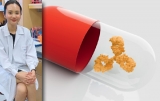
Descubren la influencia de la proteína IL-11 en longevidad y envejecimiento
Publicado en Nature, el sorprendente rol de la IL-11 se descubrió por casualidad. Equipos del Imperial College London y Duke-NUS de Singapur investigaban un método para detectar esta proteína cuando notaron algo inesperado. La clave: su función en la inflamación crónica.

Diciembre: jornada presencial de medicina orthomolecular
Organizada por EIMO Escuela Iberoamericana de Medicina Orthomolecular, el 7 de diciembre la Dra. Alejandra Rodríguez Zía presentará en Buenos Aires "Pensando a tu Paciente". Destinada a médicos, veterinarios y odontólogos, ofrecerá claves de la medicina orthomolecular aplicadas a la clínica para personalizar tratamientos.
- Mesoterapia facial, una importante terapia antienvejecimiento
- El melasma: mucho más que una mancha hormonal
- Vacunas contra el melanoma, una terapia experimental
- Hiperpigmentaciones
- Melanosis de Riehl
- Peeling: qué, cómo y cuándo
- Los cloasmas: una reacción a las hormonas
- Demuestran la utilidad de la asociación del ácido transexámico y la niacinamida en el tratamiento del melasma
- Acido tranexámico, el nuevo producto de Farmacia Vip
EL QUE BUSCA, ENCUENTRA.
Estetica-medica.info ofrece a todos los profesionales, empresas e instituciones del rubro la oportunidad de publicar gratuitamente en sus Clasificados, que cuenta con 3 tipos de avisos: Trabajo Pedido (búsqueda de personal), Trabajo Ofrecido (profesionales que buscan trabajo) y oportunidades Comerciales (compra/venta particular de equipamiento usado, fondos de comercio, alquiler, permutas, etc.).
Para publicar su aviso, complete, a continuación, el formulario online.
Encuesta
Qué le parece el nuevo sitio de EstéticaMédica.info?
VIDEOVITRINA > EQUIPOS BELLCURVS
Todos los equipos de Bellcurvs Medical & Aesthetic. Venta y alquiler. Más info
------------------------------------------------------------------------------------
Antiaging
La importancia de las vitaminas en la medicina antiaging

Lo que se trata de evitar es el proceso de oxidación prematuro de las células y, por consiguiente, su mal funcionamiento por carencias de ciertas vitaminas imprescindibles para el buen funcionamiento del medio interno. Su correcta reposición conlleva una buena evaluación médica personalizada.
Revitalización biológica y celuloterapia ortomolecular
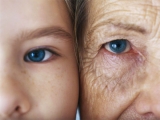
Envejecer es sinónimo de desvitalización. En cambio, la terapia biológica celular equivale a revitalizar. Es una verdadera revitalización celular. Todos los órganos de nuestro cuerpo pueden ser revitalizados con una terapia específica. El principio básico de la terapia celular es la órgano-especificidad: la piel cura a la piel, el hígado cura al hígado y así será para cada órgano o tejido tratado.
Células madre: pilar básico del proceso de renovación celular

Se multiplican mediante divisiones mitóticas para dar lugar a otras células madre idénticas. También tienen la capacidad de diferenciarse en diversos tipos de células especializadas. En tecnología cosmética hace referencia principalmente a activos de origen vegetal capaces de activar el metabolismo celular.
Neuroplasticidad, nootrópicos y regeneración neuronal

Proceso continuo que modifica las redes neuronales existentes haciendo adaptaciones estructurales y funcionales en las sinapsis, la neuroplasticidad actúa como respuesta a los cambios en el comportamiento. En otras palabras, un “recableado” del circuito neuronal cada vez que se aprende algo nuevo.
Terapia de Reemplazo Hormonal Bioidéntica, TRHB
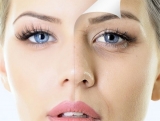
Lo primero que hay que hacer es medir hormonas para ver en qué niveles se encuentran. Una vez que se decide qué hay que suplementar, se determina la dosis y modo de administración y se le explica al paciente; después la idea es chequear los niveles hormonales a los dos meses. El tratamiento suele extenderse por tres años en mujeres con premenopausia.
El rol del gen Sirt1 en el proceso de envejecimiento

Los telómeros se acortan de forma natural con la edad, pero las conductas poco saludables pueden hacer que se acorten antes, inactivando el gen Sirt1 y acelerando los procesos de envejecimiento. La buena noticia es que científicos demostraron que es posible volver a activarlo.


